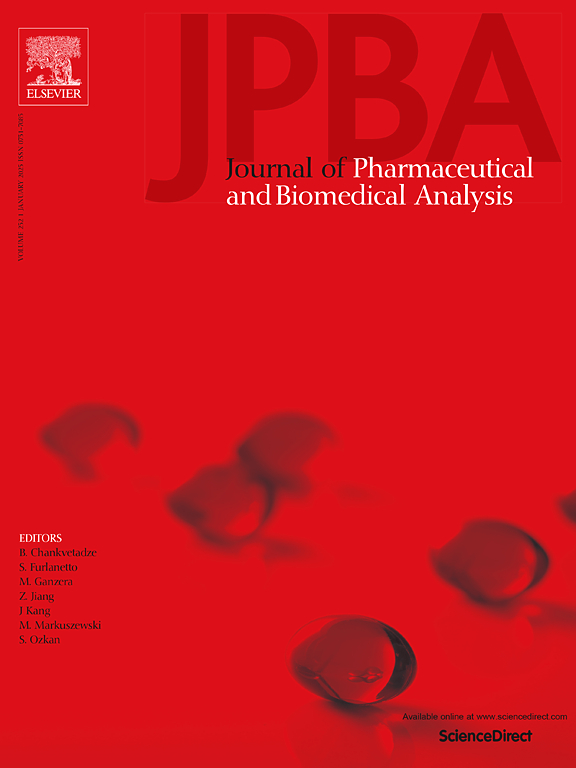Integrated cartilage metabolomics and proteomics analysis reveals the therapeutic effect of Wenjing Tongluo Decoction on Knee osteoarthritis rats
IF 3.1
3区 医学
Q2 CHEMISTRY, ANALYTICAL
Journal of pharmaceutical and biomedical analysis
Pub Date : 2025-04-04
DOI:10.1016/j.jpba.2025.116869
引用次数: 0
Abstract
Knee osteoarthritis (KOA)is an age-related degenerative whole-joint disease characterized by poor outcomes. Wenjing Tongluo Decoction (WJTLD), a Chinese herbal remedy, has demonstrated favorable clinical effects on KOA. However, the precise mechanisms therein remain poorly defined. In this study, we employed the method of anterior cruciate ligament transection (ACLT) method to establish a rat model of KOA. Following 8 weeks of oral administration of WJTLD, the morphology of knee joint cartilage was evaluated using Safranin-O/Fast green staining, H&E staining, and micro-CT imaging. Utilizing GC-MS based untargeted metabolomics and nano-LC-QE-MS based proteomics, we identified altered metabolites and proteins associated with knee cartilage in different rat groups, which were further validated through western blotting and real-time PCR. Our findings indicate that WJTLD alleviates damage to knee joint cartilage and inhibits cartilage degradation. Proteomics data revealed that the altered proteins in OA and WJTLD treated group were related to the biological process including amoebiasis, platelet activation, ECM-receptor interaction, protein digestion and absorption, and ribosome function. Western blotting results confirmed that the expression levels of MMP8 and LDHA were significantly upregulated in the KOA group but were rescued by WJTLD treatment. According to untargeted metabolomics, the intensities of lactic acid, isoleucine, lysine, glutamate, myo-inositol, adenosine, and β-alanine were significantly elevated in the KOA group, however, these metabolites experienced a dramatic following WJTLD treatment. These results suggest that WJTLD exerts a therapeutic effect on KOA by suppressing inflammation and cartilage degradation, as well as regulating multiple pathways related to ECM degradation, amino acid metabolism, and energy metabolism, including glycolysis.
综合软骨代谢组学和蛋白质组学分析揭示文静通络汤对膝关节骨性关节炎大鼠的治疗作用
膝骨关节炎(KOA)是一种与年龄相关的退行性全关节疾病,其特点是预后不良。温经通络汤是一种治疗KOA的中草药,临床疗效良好。然而,其中的确切机制仍然不明确。本研究采用前交叉韧带横断法(ACLT)建立大鼠KOA模型。口服WJTLD 8周后,采用Safranin-O/Fast绿色染色、H&;E染色和显微ct成像评估膝关节软骨形态。利用基于GC-MS的非靶向代谢组学和基于纳米lc - qe - ms的蛋白质组学,我们鉴定了不同大鼠组中与膝关节软骨相关的代谢产物和蛋白质的改变,并通过western blotting和real-time PCR进一步验证。我们的研究结果表明,WJTLD减轻膝关节软骨损伤,抑制软骨退化。蛋白质组学数据显示,OA和WJTLD治疗组的蛋白改变与阿米巴病、血小板活化、ecm受体相互作用、蛋白质消化吸收和核糖体功能等生物过程有关。Western blotting结果证实,KOA组MMP8和LDHA的表达水平明显上调,但经WJTLD处理后,MMP8和LDHA的表达水平有所恢复。根据非靶向代谢组学,乳酸、异亮氨酸、赖氨酸、谷氨酸、肌醇、腺苷和β-丙氨酸的强度在KOA组显著升高,然而,这些代谢物在WJTLD治疗后发生了显著变化。这些结果表明,WJTLD通过抑制炎症和软骨降解,以及调节包括糖酵解在内的与ECM降解、氨基酸代谢和能量代谢相关的多种途径,对KOA具有治疗作用。
本文章由计算机程序翻译,如有差异,请以英文原文为准。
求助全文
约1分钟内获得全文
求助全文
来源期刊
CiteScore
6.70
自引率
5.90%
发文量
588
审稿时长
37 days
期刊介绍:
This journal is an international medium directed towards the needs of academic, clinical, government and industrial analysis by publishing original research reports and critical reviews on pharmaceutical and biomedical analysis. It covers the interdisciplinary aspects of analysis in the pharmaceutical, biomedical and clinical sciences, including developments in analytical methodology, instrumentation, computation and interpretation. Submissions on novel applications focusing on drug purity and stability studies, pharmacokinetics, therapeutic monitoring, metabolic profiling; drug-related aspects of analytical biochemistry and forensic toxicology; quality assurance in the pharmaceutical industry are also welcome.
Studies from areas of well established and poorly selective methods, such as UV-VIS spectrophotometry (including derivative and multi-wavelength measurements), basic electroanalytical (potentiometric, polarographic and voltammetric) methods, fluorimetry, flow-injection analysis, etc. are accepted for publication in exceptional cases only, if a unique and substantial advantage over presently known systems is demonstrated. The same applies to the assay of simple drug formulations by any kind of methods and the determination of drugs in biological samples based merely on spiked samples. Drug purity/stability studies should contain information on the structure elucidation of the impurities/degradants.

 求助内容:
求助内容: 应助结果提醒方式:
应助结果提醒方式:


